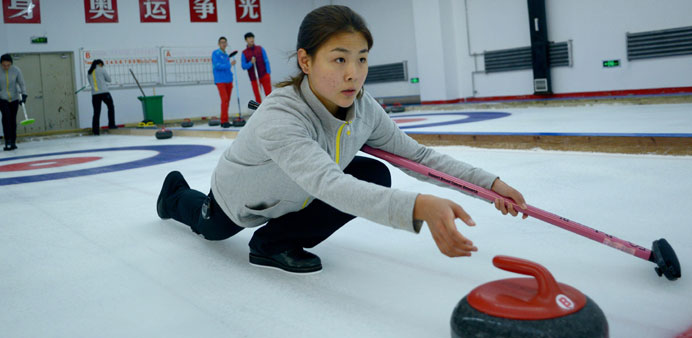This picture taken on July 2, 2015 shows a member of a curling team training at a club in Harbin, northeast China’s Heilongjiang province.
AFP/Beijing
When Liu Jinli first heard the soft rumble of curling stones slipping over Chinese ice a decade ago, the sport was virtually unknown in the country.
But a few years later she won world championship gold with China’s national curling team, securing Beijing’s place as a major power in the sport first played in medieval Scotland.
China’s rapid rise up the curling ranks is part of a wider growth in winter sports promoted by the country’s authorities as Beijing pursued its successful bid to host the 2022 Olympics.
China only settled on an official name for curling—“ice kettle”—in 1995, and had no professional teams until 2001.
Taking up the game as a teenager in the northeastern city of Harbin, Liu said the players “used to make our own footwear”.
“At the very beginning, we would buy plastic shopping bags and put them over our shoes before going out on the ice,” she said. “We had about two brooms for every 10 people.”
Now, with the financial backing of China’s General Administration of Sports, the 26-year-old and her teammates train full time throughout the year.
In summer they retreat to the seaside resort of Qinhuangdao, some 270 kilometres (170 miles) from Beijing, to build their strength with a type of tough gymnastics called callisthenics.
“Curling is a gentle sport. It’s changed my life,” said Liu after grimacing her way through an afternoon weightlifting session under the watchful eye of coach Zhang Wei.
“I think the sport has really developed quickly... there has been a great leap,” said Zhang, a former ice hockey player who 20 years ago became the first Chinese curling coach, as he looked on with an icy expression.
Games similar to ice hockey were played in China as early as the 17th century, but other winter sports are relatively new to the country.
China won its first Winter Olympic medals in 1992 and has since racked up 12 golds.
Curling got an unlikely start in China in the mid-1990s thanks to Japanese investors seeking to profit from their neighbour’s increasingly open economy.
An official from Japan’s snowy northern island of Hokkaido suggested the two countries “jointly develop the sport of curling in China”, according to the China sports administration website.
In a cold classroom in Harbin in 1995, coach Zhang recalled, Japanese curlers taught China’s first-ever class on the sport’s combination of precise stone throwing and tactical sweeping.
The deeply strategic sport sees athletes “throw”, or slide, heavy, circular granite stones across a long stretch of ice towards a target, with two sweepers wielding brooms rushing along the stone’s path in an attempt to influence its track without touching, or “burning”, the rock.
Icy nations such as Canada and Sweden have long dominated the sport, which secured an official Winter Olympic billing at Nagano in 1998.
But within a few years of the class in Harbin, Chinese teams were competing abroad, and officials “saw that we might be able to get good results in a relatively short time”, Zhang said.
Harbin city funded China’s first professional men’s team in 2001, hiring coaches from Canada to raise standards, but it was the women curlers—nicknamed the “five gold flowers”—who took the country’s first world title.
With the last strike of the 2009 final, captain Wang Bingyu carefully unleashed a perfectly paced and targeted shot that knocked out two Swedish scoring stones, secured gold for China—and triggered a blood-curdling scream of victory from one of her team-mates.
The men’s squad scooped a bronze at the 2010 Winter Olympics, and both are currently ranked in the world’s top five.
Zhang said that curling was “very suitable for Asians, as Asians have flexible thinking”. But despite a population of almost 1.4 billion, China is thought to have just a few hundred curlers, almost no grassroots teams, and only three venues.
Government spending was key to the teams’ success, he said, and investment aimed at securing medals is expected to increase in the run-up to 2022.
“All the sports which China is promoting are government-sponsored sports, there is only a very small grass-roots sports movement in China,” said Xu Guoqi, a Hong Kong based professor and author of a book on China’s Olympic movement.
“In major Winter Olympic sports like skiing, China will have trouble because it will take ages to train the best athletes. But for curling, I guess within a few years you can do very well if you train players full time,” he added.
The next generation of Chinese curlers train at the Linxian Curling club in Harbin, where average daily temperatures plunge as low as -24 degrees Celsius (-11 Fahrenheit) in January.
“Most of the funding for curling comes from the government. No matter if it’s money for training, competitions, coaches or players, it’s the state which provides a guarantee,” said the school’s head Wang Jingang.


